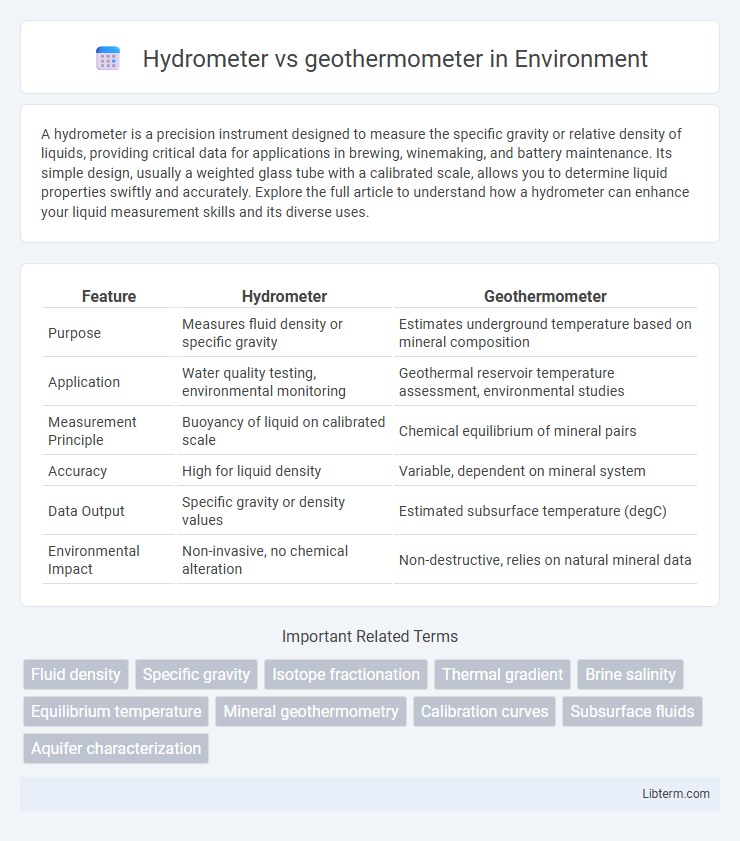A hydrometer is a precision instrument designed to measure the specific gravity or relative density of liquids, providing critical data for applications in brewing, winemaking, and battery maintenance. Its simple design, usually a weighted glass tube with a calibrated scale, allows you to determine liquid properties swiftly and accurately. Explore the full article to understand how a hydrometer can enhance your liquid measurement skills and its diverse uses.
Table of Comparison
| Feature | Hydrometer | Geothermometer |
|---|---|---|
| Purpose | Measures fluid density or specific gravity | Estimates underground temperature based on mineral composition |
| Application | Water quality testing, environmental monitoring | Geothermal reservoir temperature assessment, environmental studies |
| Measurement Principle | Buoyancy of liquid on calibrated scale | Chemical equilibrium of mineral pairs |
| Accuracy | High for liquid density | Variable, dependent on mineral system |
| Data Output | Specific gravity or density values | Estimated subsurface temperature (degC) |
| Environmental Impact | Non-invasive, no chemical alteration | Non-destructive, relies on natural mineral data |
Introduction to Hydrometers and Geothermometers
Hydrometers measure the specific gravity or density of liquids, essential for applications like fluid quality control and industrial processes. Geothermometers estimate subsurface temperatures by analyzing the chemical composition of geothermal fluids, providing critical data for geothermal energy exploration. These instruments serve distinct roles in identifying fluid properties and subsurface thermal conditions.
Principles of Operation: Hydrometer vs Geothermometer
A hydrometer measures the specific gravity or density of a liquid by floating at a level that corresponds to the liquid's mass per unit volume, based on Archimedes' principle. A geothermometer estimates subsurface temperature by analyzing the chemical composition or isotopic ratio of geothermal fluids, relying on temperature-dependent equilibrium reactions. While a hydrometer operates on physical buoyancy principles, a geothermometer uses geochemical thermodynamics to infer temperature conditions.
Types and Variations
Hydrometers are precision instruments used to measure the density or specific gravity of liquids, with common types including the floating hydrometer, digital hydrometer, and micro-hydrometer, each optimized for different fluid viscosities and temperature ranges. Geothermometers estimate subsurface temperatures based on chemical composition and isotopic ratios in geothermal fluids, with variations such as silica geothermometers, cation geothermometers, and isotopic geothermometers, tailored for distinct geothermal reservoir conditions. The selection between hydrometer and geothermometer types depends heavily on the application context, fluid properties, and required measurement accuracy.
Key Applications in Industry and Science
Hydrometers are primarily used in industries such as brewing, automotive, and chemical manufacturing to measure liquid density and specific gravity, aiding in quality control and process monitoring. Geothermometers find critical applications in geothermal energy exploration, volcanology, and environmental science by estimating subsurface temperatures through mineral and water chemistry analysis. Both instruments support scientific research and industrial operations by providing precise measurements essential for system optimization and resource management.
Accuracy and Reliability Comparison
Hydrometers provide direct measurements of liquid density and specific gravity with high accuracy under controlled laboratory conditions, but their reliability decreases with temperature fluctuations and sample contamination. Geothermometers estimate subsurface temperatures based on chemical equilibrium of mineral assemblages, offering indirect yet valuable temperature approximations in geothermal studies, though accuracy depends on calibration quality and geological context. Both instruments serve distinct purposes, with hydrometers excelling in precise fluid property analysis and geothermometers providing reliable temperature estimates for geothermal exploration when calibrated correctly.
Pros and Cons of Hydrometers
Hydrometers provide a simple, cost-effective method for measuring the density or specific gravity of liquids, making them valuable in various industries such as brewing, chemical manufacturing, and environmental monitoring. Their advantages include ease of use, portability, and no need for electronic power sources, but they often suffer from lower precision and potential user error compared to digital or electronic instruments. Limitations include sensitivity to temperature variations, the requirement for clean and homogeneous liquid samples, and difficulty in measuring highly viscous or turbulent fluids.
Benefits and Limitations of Geothermometers
Geothermometers provide critical data for estimating subsurface temperatures by analyzing the chemical composition of geothermal fluids, which aids in resource assessment and sustainable management of geothermal reservoirs. Their benefits include non-invasiveness and applicability in regions where direct temperature measurement is challenging, yet limitations arise due to chemical alterations and mixing of fluids that can skew temperature estimations. Accurate geothermometer readings depend on stable chemical equilibrium and require calibration for specific geological contexts to improve reliability in geothermal exploration.
Selection Criteria: Choosing the Right Instrument
Selecting the right instrument between a hydrometer and a geothermometer depends on the specific measurement needs: hydrometers are ideal for determining liquid density or specific gravity in various liquids, while geothermometers are used to estimate subsurface temperature based on geochemical data. Accuracy requirements, sample type, and environmental conditions influence selection, with hydrometers suited for laboratory and field use in fluids like water or oil, and geothermometers preferred in geothermal reservoir analysis. Understanding the measurement context and desired data ensures optimal instrument choice for precise and reliable results.
Common Mistakes and Troubleshooting
Common mistakes when using hydrometers and geothermometers include incorrect calibration, improper immersion depth, and temperature measurement errors, which can lead to inaccurate readings of fluid density or geothermal temperatures. Troubleshooting involves verifying instrument calibration against standard references, ensuring correct positioning in the fluid or geothermal sample, and maintaining consistent environmental conditions to minimize fluctuations. Proper maintenance and regular recalibration improve measurement accuracy and reliability in both hydrometric and geothermometric applications.
Future Trends in Temperature and Density Measurement
Emerging advancements in hydrometer and geothermometer technologies emphasize enhanced precision through integration with IoT sensors and real-time data analytics, enabling more accurate temperature and density measurements in geothermal and fluid dynamics applications. Machine learning algorithms are being utilized to interpret complex datasets from hydrometers and geothermometers, improving predictive modeling and reducing calibration errors. Future trends also highlight miniaturization and wireless connectivity, facilitating remote monitoring and continuous environmental assessment in challenging or inaccessible locations.
Hydrometer Infographic

 libterm.com
libterm.com